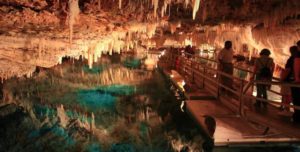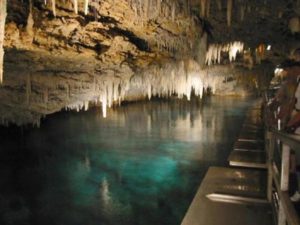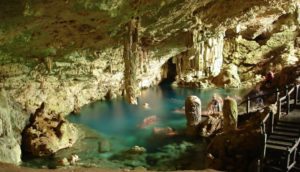 THE CAVES OF BELLAMAR, A BEAUTIFUL AND SURPRISING NATURAL SHOW.
THE CAVES OF BELLAMAR, A BEAUTIFUL AND SURPRISING NATURAL SHOW.
The Bellamar Caves are located on the north coast of Cuba, about five kilometers from the center of the city of Matanzas. Already inside the beautiful caves the visitor can appreciate the effect of time on its beautiful stalactites, stalagmites and other formations.
The galleries and passages of these caves began to form about 30 million years ago. Originally, the plain in which the caves are located was under the sea, it was part of the bay of Matanzas. Throughout the so-called Bellamar Fault, the underground water, in combination with the carbon dioxide, was dissolving the calcareous rock and in this way creating underground chambers in the subsoil; under the bottom of the sea. While these caverns remained below sea level they were full of water. Then, to tectonic consequences (movements in the terrestrial layers), this area rose; forming the marine terraces that are noticed in the lands in the city of Matanzas and its surroundings.
FORMATION OF THE CAVES OF BELLAMAR.
Eventually the caves dried up; draining even cavities that are deep below sea level. Then leaks began between the rocks on the roof of the caves. These leaks of water with dissolved lime carbonate were leaving residues where they dripped, forming the stalactites that hang from the ceiling and the stalagmites in the ground. The stalactites at the beginning are cylindrical, according to their size increases they take the conical form. The stalagmites are usually conical or flattened, as if melted. The stalactites grow and the stalagmites also, forming columns when the two come together. In certain cases several stalactites are relatively close, and as their proportions increase, they unite, giving rise to formations called matos. Other times they run next to the wall, and those are the waterfalls. In the Bellamar Caves you can see all these formations and even more interesting is that although they already have their years, in terms of caves they are relatively young; which in common language means that even these formations are originating and those already known, growing.
Something very interesting about the Bellamar Caves is that there are also crystalline formations that look transparent and shiny. These formations do not originate in the same way as stalactites and other structures mentioned. These crystals have their origin in geodes filled with water. Even more interesting is that in certain cavities of the caves the sedimentary formations are covered by a crystalline layer. This indicates that after drying, these chambers were flooded completely, or at least partially. These caves present an unusual beauty in the world of the caves since many of the formations are resplendent due to the crystalline layer that covers them.
The entrance to the Bellamar Caves is through the cavity called the Gothic Hall. It is a square-shaped camera and measures about 80 meters long by about 25 meters wide. In this room some of the formations have been named; among others is El Huerto de las Carrots, The Chapel of the Twelve Apostles, Doña Mamerta and perhaps the most famous is the Manto de Colón. But the Bellamar Caves are not just this room, the cavity extends to the east and west achieving a length that exceeds three kilometers long; and it is estimated to be much bigger and with cameras still totally flooded. There is also at least one other cavity almost parallel to the north. Other cavities include the Gallery of the Two Lakes, the Hall of Sponges, the Gallery of the Dwarves and the Gallery of the Megalocnus east of the Gothic Hall. In the other direction are the Hatuey passage, the Ladies’ Hall, the Las Dalias Lake and the Baño de la Americana (before the English).
DISCOVERY OF THE CAVES OF BELLAMAR.
These caves were discovered by chance. In February 1861 a slave lost his bar when he opened a hole in the ground trying to remove a lime rock. Apparently the slave, and even the foreman, imagined that the earth had swallowed the bar because that caused fright. Don Manuel Santos Parga, the owner of the farm where the quarry of these rocks was located, which were taken to a lime kiln that was also in that locality, I asked for explanations and after two months when he did not receive answers he went to the place of the facts.
This Mr. Parga, as the story mentions, was understood in things of mines and caves. He immediately realized what the discovery meant and began to prepare the cave so that visitors could enjoy it. Many stones were removed; masonry stairs were made that are still in use; to the stairs he installed handrails; and as soon as it was a reality, he installed electric light. Then he or one of the guides under his employment took the tourists through the passageways of the cave while explaining in detail what they were seeing. Remember that at that time Varadero was still a beach of mosquitoes and salt flats. The cities also had much fewer inhabitants and Henry Ford was about to invent the assembly line, there were no cars. Even so, in the first two years that Parga opened her cave to the public, more than two thousand people visited her. In those times, a resounding success both tourist and scientific. A success that is more than one hundred and forty years old and still continues to be done as Mr. Parga did.
Originally it was called La Cueva de Parga, which, as we already know, was the owner of the farm where the cave was discovered, the first to explore them and the first to show them to the world. By the way, according to the scientists it is a single cave with several rooms, but as the custom treats it in the plural, we present it. Soon after the name was changed to Las Cuevas de Bellamar due to its proximity to the beach of Bellamar, west of the city of Matanzas and on the coast of the bay, where at that time it had begun to build some summer houses .
THE CAVES OF BELLAMAR TODAY.
As already mentioned, the sections that have been explored have a total length of 3,225 meters (just over three kilometers). There are several galleries that run parallel and on several levels. In total they have a length of about twenty kilometers, which is considerable but not amazing in the underworld; Mammoth Cave in Kentucky, United States, achieve about 580 kilometers. Of course, it is estimated that in the Bellamar Caves there is still much more to know and the Mammoth Cave is one of the most explored in the world. The one we present here is not the only one with crystalline formations. The Jewel Cave in the Black Hills of South Dakota, United States, has much more amazing crystalline formations, but that does not take away the grace of Bellamar, which in itself is a beauty.
Some sections are fifty meters below sea level. We understand that tourists are not allowed to go so deep; rather like up to half this depth. The air is breathable, at least where it was allowed to reach the visitor. The temperature is relatively stable throughout the year, staying at about 80ºF (26ºC).
 LAS CUEVAS DE BELLAMAR, CUBA, UN ESPECTÁCULO NATURAL SORPRENDENTE.
LAS CUEVAS DE BELLAMAR, CUBA, UN ESPECTÁCULO NATURAL SORPRENDENTE.
Las Cuevas de Bellamar se encuentran en la costa norte de Cuba, a unos cinco kilómetros del centro de la ciudad de Matanzas. Ya dentro de las hermosas cuevas el visitante puede apreciar el efecto del tiempo en sus bellas estalactitas, estalagmitas y otras formaciones.
Las galerías y pasadizos de estas cuevas comenzaron a formarse hace unos 30 millones de años. Originalmente la planicie en la cual están las cuevas se encontraban bajo el mar, era parte de la bahía de Matanzas. A lo largo de la llamada Falla de Bellamar el agua subterránea, en combinación con el carbón dióxido, fue disolviendo la roca calcárea y de esta forma creando cámaras subterráneas en el subsuelo; bajo el fondo del mar. Mientras que estas cavernas permanecieron bajo el nivel del mar se encontraban llenas de agua. Entonces, a consecuencias tectónicas (movimientos en las capas terrestres), esta zona se elevó; formando las terrazas marinas que se notan en los terrenos en la ciudad de Matanzas y sus alrededores.
FORMACIÓN DE LAS CUEVAS DE BELLAMAR.
Eventualmente las cavernas se fueron secando; desaguándose aun cavidades que están a gran profundidad bajo el nivel del mar. Después comenzaron las filtraciones por entre las rocas sobre el techo de las cuevas. Estas filtraciones de agua con carbonato de cal disuelto fueron dejando residuos donde goteaban, formándose las estalactitas que cuelgan del techo y las estalagmitas en el suelo. Las estalactitas al principio son cilíndricas, según su tamaño aumenta toman la forma cónica. Las estalagmitas usualmente son cónicas o aplanadas, como derretidas. Las estalactitas crecen y las estalagmitas también, formándose columnas cuando las dos se unen. En ciertos casos varias estalactitas están relativamente cercas, y según sus proporciones aumentan se van uniendo, dando lugar a las formaciones llamadas matos. Otras veces corren próximas a la pared, y esas son las cascadas. En las Cuevas de Bellamar se ven todas estas formaciones y aún más interesante es que a pesar que ya tienen sus añitos, en términos de cuevas son relativamente jóvenes; lo cual en lenguaje común quiere decir que aun estas formaciones se están originando y las ya conocidas, creciendo.
Algo muy interesante de las Cuevas de Bellamar es que en ellas también hay formaciones cristalinas de aspecto transparente y brilloso. Estas formaciones no se originan de la misma manera que las estalactitas y otras estructuras mencionadas. Estos cristales tienen su origen en geodas llenas de agua. Aún más interesante es que en ciertas cavidades de las cuevas las formaciones sedimentarias son cubiertas por una capa cristalina. Lo cual indica que después de haberse secado, estas cámaras volvieron a inundarse totalmente, o al menos parcialmente. Estas cuevas presentan una belleza poco común en el mundo de las cavernas ya que muchas de las formaciones son resplandecientes debido a la capa cristalina que las cubre.
La entrada a las Cuevas de Bellamar es por la cavidad llamada Salón Gótico. Es una cámara de forma cuadricular y mide unos 80 metros de largo por unos 25 metros de ancho. En este salón se le han dado nombre a algunas de las formaciones; entre otras se encuentra El Huerto de las Zanahorias, La Capilla de los Doce Apóstoles, Doña Mamerta y tal vez el más famoso sea el Manto de Colón. Pero las Cuevas de Bellamar no son sólo este salón, la cavidad se extiende hacia el este y el oeste logrando una longitud que sobrepasa los tres kilómetros de largo; y se estima que sea mucho más grande y con cámaras aún totalmente inundadas. También hay al menos otra cavidad casi paralela al norte. Otras de las cavidades son la Galería de los Dos Lagos, el Salón de las Esponjas, la Galería de los Enanos y la Galería de los Megalocnus al este del Salón Gótico. En la otra dirección se encuentran el pasadizo de Hatuey, Salón de las Damas, Lago de las Dalias y el Baño de la Americana (antes de la Inglesa).
DESCUBRIMIENTO DE LAS CUEVAS DE BELLAMAR.
Estas cuevas fueron descubiertas por casualidad. En febrero de 1861 un esclavo perdió su barreta al abrir un hueco en el suelo tratando de remover una roca de cal. Aparentemente el esclavo, y aun del mayoral, se imaginaron que la tierra se había tragado la barreta porque aquello causó espanto. Don Manuel Santos Parga, el dueño de la finca donde se encontraba la cantera de estas rocas que eran llevadas a un horno de cal que también estaba en esa localidad, pido explicaciones y al cabo de dos meses al no recibir respuestas se dirigió al lugar de los hechos.
Este señor Parga, como menciona el relato, era entendido en cosas de minas y cuevas. De inmediato se dio cuenta de lo que el descubrimiento significaba y comenzó a preparar la cueva para que los visitantes pudieran disfrutarla. Se sacaron muchas piedras; se hicieron escaleras de mampostería que aun están en uso; a las escaleras le instaló pasamanos; y tan pronto fue una realidad, instaló luz eléctrica. Entonces él o uno de los guías bajo su empleo llevaban a los turistas por los pasadizos de la cueva mientras con lujo de detalles explicaban lo que estaban viendo. Recuerde que en ese tiempo Varadero aún era una playa de mosquitos y salinas. También las ciudades tenían mucho menos habitantes y Henry Ford estaba por inventar la línea de ensamblaje, no habían automóviles. Aun así, en los dos primeros años que Parga abrió su cueva al público, más de dos mil personas la visitaron. En aquellos tiempos, un éxito rotundo tanto turístico como científico. Un éxito que ya tiene más de ciento cuarenta años y aun se sigue haciendo tal y como el señor Parga lo hacía.
Originalmente se le llamó La Cueva de Parga, que como ya sabemos era el dueño de la finca donde se descubrió la cueva, el primero en explorarlas y el primero en enseñárselas al mundo. Por cierto, de acuerdo a los científicos es una sola cueva con varios salones, pero como la costumbre la trata en plural, así la presentamos. Poco después se le cambió el nombre a Las Cuevas de Bellamar debido a su proximidad a la playa de Bellamar, al oeste de la ciudad de Matanzas y en la costa de la bahía, donde en aquel tiempo se había comenzado a edificar unas casas de verano.
LAS CUEVAS DE BELLAMAR HOY.
Como ya mencionamos, las secciones que se han explorado tienen una longitud total de 3,225 metros (poco más de tres kilómetros). Son varias galerías que corren paralelas y a varios niveles. En total tienen un largo de unos veinte kilómetros, lo cual es considerable pero no asombroso en el mundo subterráneo; la Cueva Mammoth en Kentucky, Estados Unidos, logran cerca de 580 kilómetros. Claro, se estima que en las Cuevas de Bellamar aun hay mucho más por conocer y la Cueva Mammoth es una de las más exploradas en el mundo. La que presentamos aquí tampoco es la única con formaciones cristalinas. La Jewel Cave en las Black Hills de South Dakota, Estados Unidos, tiene formaciones cristalinas mucho más asombrantes, pero eso no le quita la gracia a las de Bellamar, que de por sí son una belleza.
Algunas secciones están a cincuenta metros bajo el nivel del mar. Tenemos entendido que a los turistas no se les permite ir tan profundo; más bien como hasta la mitad de esta profundidad. El aire es respirable, al menos donde se le permitía llegar al visitante. La temperatura es relativamente estable todo el año, manteniéndose a unos 80ºF (26ºC).
Agencies/Wiki/Bellamar Caves/ Internet Photos/ Arnoldo Varona/ TheCubanhistory.com
THE CUBAN HISTORY, HOLLYWOOD.










